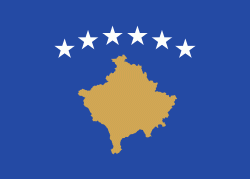Peć (Komuna e Pejës)
Peja (Indefinite Albanian form: Pejë ) or Peć (Пећ ) is the fourth largest city of Kosovo and seat of Peja Municipality and Peja District. It is situated in the region of Rugova on the eastern section of the Accursed Mountains along Peja's Lumbardh in the western part of Kosovo.
In medieval times the city, then commonly known under its Serbian name, was the seat of the Serbian Orthodox Church in 1346. The Patriarchal monastery of Peć is a UNESCO World Heritage Site as part of the Medieval Monuments in Kosovo. Under Ottoman rule the city, then commonly known under the Turkish name İpek, became a district capital with mosques and civil architecture. From the end of the nineteenth century until today, the city has been the site of nationalist aspirations and claims for both ethnic Albanians and Serbs, often resulting in tense inter-ethnic relations and conflict.
According to the 2011 census, the city of Peja has 48,962 inhabitants, while the municipality has 96,450 inhabitants. The municipality covers an area of 602 km2, including the city of Peja and 95 villages; it is divided into 28 territorial communities.
In Serbian, peć means "furnace" or "cave", and its name is probably connected with nearby caves in the Rugova Canyon which served as hermit cells for Serbian Orthodox monks. In medieval Ragusan documents, the Serbian name of the city (Peć, lit. "furnace") is sometimes translated as Forno, meaning "furnace" in Italian. During Ottoman rule, it was known as Ottoman Turkish İpek (ايپك). The Albanian name's definite form is Peja and the indefinite Pejë, which descents from the name Siparantum. Other names of the city include Latin Pescium and Greek Episkion (Επισκιον). The city was first mentioned as Siparantum, by Ptolemy in his work Gheographia.
In medieval times the city, then commonly known under its Serbian name, was the seat of the Serbian Orthodox Church in 1346. The Patriarchal monastery of Peć is a UNESCO World Heritage Site as part of the Medieval Monuments in Kosovo. Under Ottoman rule the city, then commonly known under the Turkish name İpek, became a district capital with mosques and civil architecture. From the end of the nineteenth century until today, the city has been the site of nationalist aspirations and claims for both ethnic Albanians and Serbs, often resulting in tense inter-ethnic relations and conflict.
According to the 2011 census, the city of Peja has 48,962 inhabitants, while the municipality has 96,450 inhabitants. The municipality covers an area of 602 km2, including the city of Peja and 95 villages; it is divided into 28 territorial communities.
In Serbian, peć means "furnace" or "cave", and its name is probably connected with nearby caves in the Rugova Canyon which served as hermit cells for Serbian Orthodox monks. In medieval Ragusan documents, the Serbian name of the city (Peć, lit. "furnace") is sometimes translated as Forno, meaning "furnace" in Italian. During Ottoman rule, it was known as Ottoman Turkish İpek (ايپك). The Albanian name's definite form is Peja and the indefinite Pejë, which descents from the name Siparantum. Other names of the city include Latin Pescium and Greek Episkion (Επισκιον). The city was first mentioned as Siparantum, by Ptolemy in his work Gheographia.
Map - Peć (Komuna e Pejës)
Map
Country - Kosovo
 |
 |
In classical antiquity, the central tribe which emerged in the territory of Kosovo were the Dardani, who formed an independent polity known as the Kingdom of Dardania in the 4th century BC. It was annexed by the Roman Empire by the 1st century BC, and for the next millennium, the territory remained part of the Byzantine Empire, whose rule was eroded by Slavic invasions beginning in the 6th–7th century AD. In the centuries thereafter, control of the area alternated between the Byzantines and the First Bulgarian Empire. By the 13th century, Kosovo became the core of the Serbian medieval state, and has also been the seat of the Serbian Orthodox Church from the 14th century, when its status was upgraded to a patriarchate. Ottoman expansion in the Balkans in the late 14th and 15th century led to the decline and fall of the Serbian Empire; the Battle of Kosovo of 1389 is considered to be one of the defining moments in Serbian medieval history. The Ottomans fully conquered the region after the Second Battle of Kosovo. The Ottoman Empire ruled the area for almost five centuries until 1912.
Currency / Language
| ISO | Language |
|---|---|
| SQ | Albanian language |
| SR | Serbian language |















